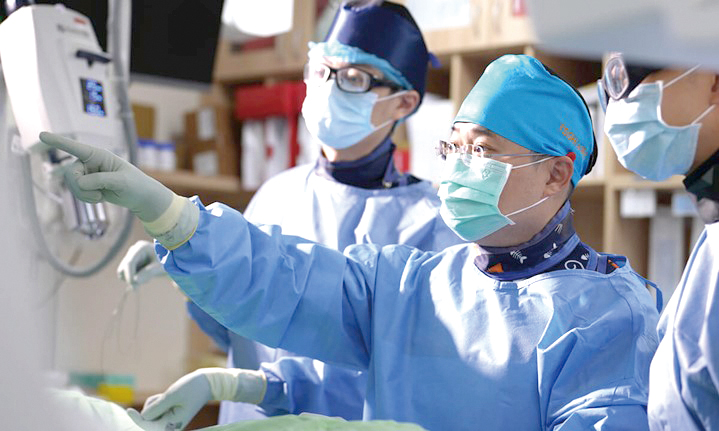Preoperative Downstaging Increases the Chances of Reversing Intermediate- and Advanced-Stage Liver Cancer
Update Date:2024/09/05,
Views:188
According to statistics from the Ministry of Health and Welfare, approximately 12,000 people in Taiwan die each year from chronic liver disease, cirrhosis, and liver cancer. Among these, liver cancer is the second leading cause of cancer-related deaths in the country, and it has been consistently ranked among the top two for 42 years, alongside lung cancer.
Dr. Chang Wei-chou, Director of the Department of Radiology at our hospital, notes that liver cancer treatment in Taiwan has become more diverse. For early-stage liver cancer, options include surgical resection or liver transplantation; even a single tumor smaller than 3 cm can often be cured through surgery. However, the treatment of intermediate- and advanced-stage liver cancer is more complex and varied. Typically, after diagnosis, patients will have their cases discussed by a tumor treatment team to develop personalized treatment recommendations based on their specific conditions.
Recent years have seen significant changes in the treatment of advanced liver cancer. Large-scale domestic and international studies have shown that, unlike in the past when single-targeted drugs were used, new combinations of immune and targeted therapies, or dual immune therapies, have proven more effective than single-targeted drug treatments for advanced liver cancer. For patients with intermediate- and advanced-stage liver cancer who cannot undergo surgery, receiving a combination of treatments, especially with localized embolization therapy, can offer about 20-30% of patients the possibility of "downstaging" and potentially qualify for future surgery or liver transplantation.
For other intermediate- and advanced-stage liver cancer patients, while surgical eradication of the liver tumor may not be feasible, a combination of localized liver cancer embolization therapy with immunotherapy or targeted therapy can extend the median survival to approximately 30 months, meaning that half of the patients may live beyond 30 months.
Mr. Chang was diagnosed with liver cancer in 2021. However, within less than six months, his tumor rapidly progressed to advanced liver cancer, involving a large area of multiple liver lobes and also invading the right portal vein, making surgical resection impossible. Consequently, the surgical team referred Mr. Chang to the Department of Radiology, hoping that Dr. Chang Wei-chou could perform Yttrium-90 glass microsphere therapy.
After accepting Yttrium-90 glass microsphere therapy and more than two and a half years of follow-up, recent imaging has shown that the right liver has atrophied while the left liver has enlarged compensatorily. The tumor has almost completely disappeared, and Mr. Chang has also achieved a good quality of life.
Currently, the Tri-Service General Hospital employs three types of embolization treatments:
1. Traditional Chemotherapy Embolization: This method involves delivering chemotherapy drugs mixed with iodine oil into the hepatic artery, followed by occlusion of the blood vessels with gelatin sponge. While effective, this approach offers relatively short-term results and is associated with significant side effects.
2. Drug-Eluting Microsphere Embolization: In this method, microspheres loaded with chemotherapy drugs are delivered into small blood vessels. The therapeutic effect lasts from 14 to 31 days, and the side effects are milder compared to traditional methods. However, frequent treatments are required for larger liver tumors.
3. Internal Radiation Therapy (Yttrium-90 Glass Microsphere Therapy): This involves injecting high-radiation microspheres into the hepatic artery. The microspheres concentrate in the tumor's small blood vessels, providing a high dose of radiation to the tumor from a close distance. The effects can last between 3 to 6 months, with relatively mild discomfort.
Dr. Chang Wei-chou emphasizes that the greatest advantage of Yttrium-90 glass microsphere therapy is its suitability for large malignant tumors that invade the portal vein, which are often beyond the reach of traditional treatments. This approach provides a potential curative opportunity for patients who previously had no options. According to the experience at Tri-Service General Hospital, 20% of patients have successfully undergone surgery or liver transplantation after this treatment, breaking through the limitations of conventional therapies.
However, Dr. Chang Wei-chou also points out that this therapy is not suitable for all patients. Prior to treatment, a two-stage evaluation is required. The first stage assesses the distribution of small blood vessels and dosage. If a significant proportion of these vessels lead to the lungs or gastrointestinal tract, the therapy is not recommended to avoid complications such as pulmonary fibrosis. For those who are suitable, a second stage involves a precise treatment period of about two weeks.
Currently, treatment for intermediate- and advanced-stage liver cancer is no longer a solitary endeavor; interdisciplinary collaborative treatment is becoming increasingly common. The combination of Yttrium-90 microsphere therapy with immunotherapy and targeted therapy allows physicians and patients to develop the most appropriate treatment strategy based on factors such as age, tumor condition, liver function, and economic situation, aiming to achieve the best possible treatment outcomes.
Dr. Chang Wei-chou, Director of the Department of Radiology
